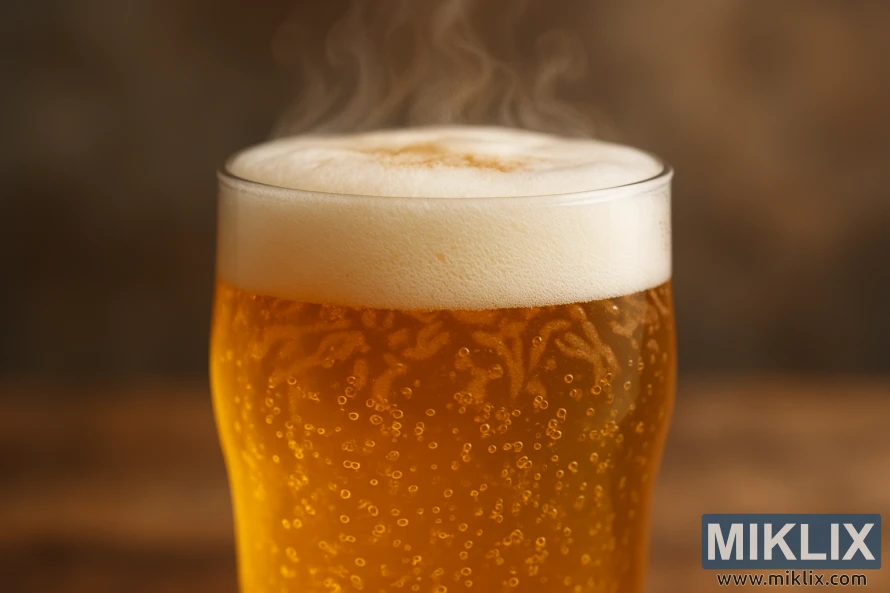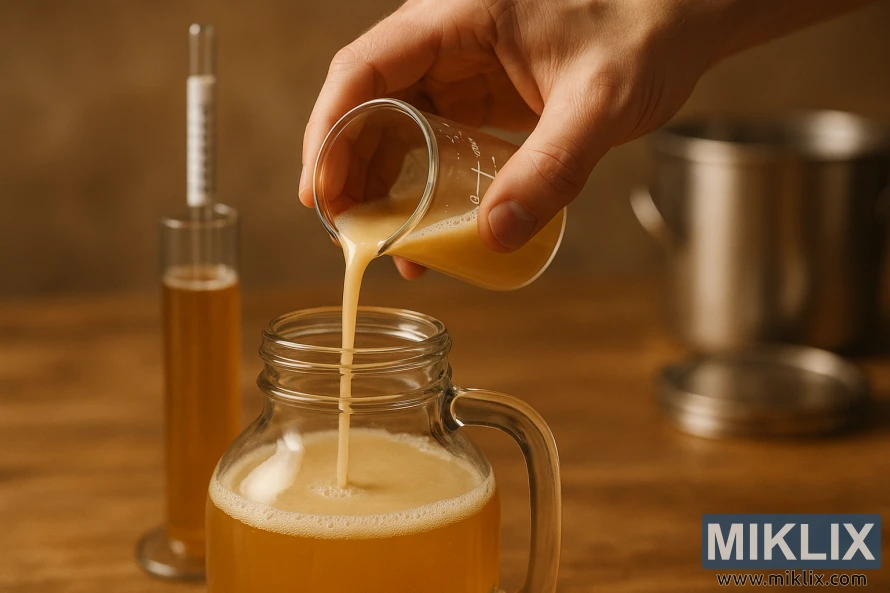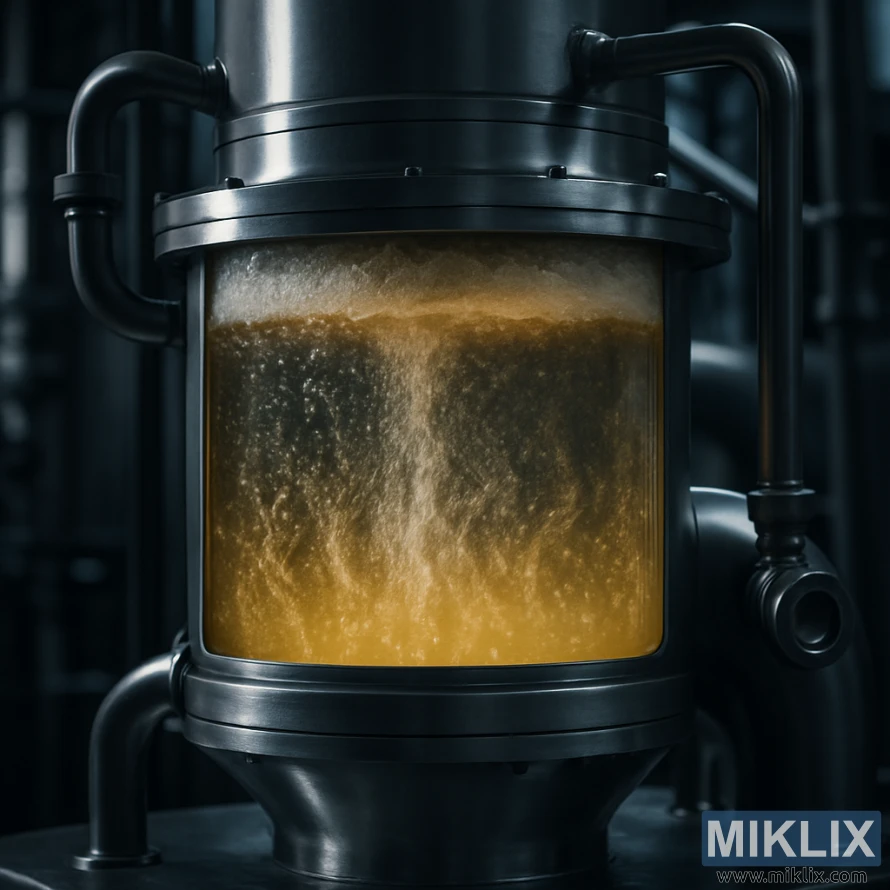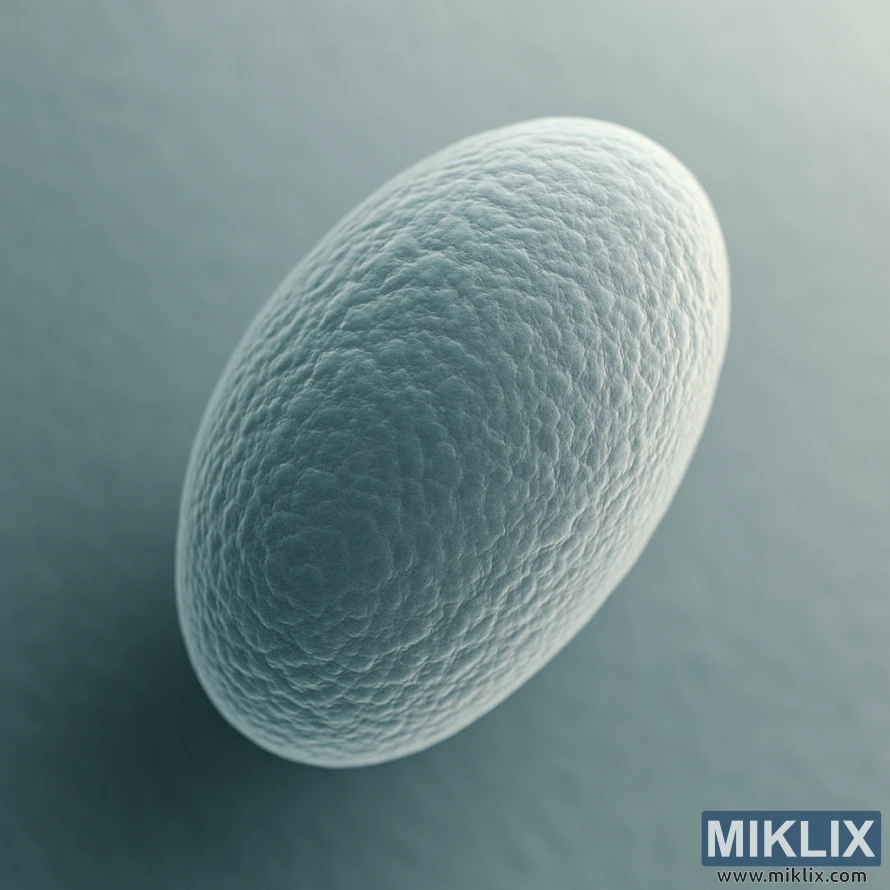Fermenting Beer with Wyeast 2308 Munich Lager Yeast
Published: November 1, 2025 at 10:40:27 PM UTC
This article serves as a practical, evidence-based guide for homebrewers. It focuses on Wyeast 2308 Munich Lager Yeast. The content is structured to resemble a detailed product review and a long-form fermenting guide. It aims to provide insights into handling, fermentation behavior, and troubleshooting tips for lager yeast 2308.

Wyeast 2308 is renowned for its ability to produce traditional German styles like Helles and Munich-style lagers. This guide offers clear advice on flavor expectations, temperature ranges, and pitching rates. It also covers starter recommendations, diacetyl rest routines, pressure fermentation, and lagering schedules.
Readers will discover how fermenting with 2308 can enhance malt-forward profiles. They will learn when to increase temperatures for better attenuation and how to prevent off-flavors. This review draws on community reports and brewing practices to offer actionable steps for batches ranging from 1 to 10 gallons.
Key Takeaways
- Wyeast 2308 Munich Lager Yeast excels in Helles and Munich-style lagers with a malt-forward character.
- Follow the Wyeast 2308 fermentation guide for temperature and starter recommendations to ensure healthy attenuation.
- Pitching rate and a proper starter reduce lag and improve fermentation consistency when fermenting with 2308.
- Diacetyl rest and controlled lagering are essential to get a clean finish from lager yeast 2308.
- This Munich lager yeast review emphasizes evidence-based tips and community-tested practices for reliable results.
Introduction to Wyeast 2308 Munich Lager Yeast
Wyeast 2308 introduction is for brewers seeking a traditional German lager yeast. This Munich lager strain is celebrated for creating clean, malty lagers like Helles, Märzen, and Dunkel. It also offers a hint of ester complexity when fermentation warms slightly.
For a detailed Wyeast 2308 overview, note that Wyeast's official documentation is sparse. Homebrewers often rely on forum reports and brew logs for insights. These sources reveal consistent attenuation, steady flocculation, and a low phenolic profile in the lower lager range.
Experienced brewers highlight the yeast's forgiving nature during cold lagering and its subtle malt-forward profile. Some mention a mild diacetyl tendency, which can be managed with a short diacetyl rest and careful temperature control.
This article draws from brewer reports and practical brewing notes to provide actionable guidance. The Wyeast 2308 overview here combines hands-on experience with common patterns from online communities. It offers clear expectations for fermentation and flavor development.
Target readers include homebrewers with chillers or freezers and those interested in both classic lagering and experimental warm-fermentation approaches. This Munich lager strain excels in traditional cold schedules but also rewards cautious experimentation at higher temperatures for varied ester profiles.
Flavor Profile and Sensory Characteristics of Wyeast 2308
Brewers often describe the Wyeast 2308 flavor profile as clean and malt-forward, reminiscent of Munich-style lagers. The Munich lager yeast taste is notable for its firm malt backbone and crisp finish. This makes it well-suited for darker lagers and amber styles.
The sensory characteristics 2308 include mild esters, which can sometimes lean towards isoamyl acetate. This gives a faint banana-like hint, noticeable when fermentation is warmer or under-stressed. If a diacetyl rest is skipped, esters and diacetyl 2308 can appear together. This may accentuate fruity and buttery tones.
Compared to other lager strains, Wyeast 2308 produces modest amounts of sulfur. Sulfur may be present under specific temperature or oxygen conditions. It usually diminishes during cold conditioning.
To achieve the desired Munich lager yeast taste, a proper diacetyl rest followed by several weeks of lagering is essential. This process reduces both esters and diacetyl 2308 levels. The final beer is clean, crisp, and balanced, with a subtle Munich malt character and minimal off-flavors.
- Primary notes: malt-forward, clean finish
- Possible transient notes: mild isoamyl acetate (banana)
- Off-flavor risk: diacetyl if rest is omitted
- Post-rest profile: clean Munich-style clarity

Fermentation Temperature Ranges and Effects
The fermentation temperature of Wyeast 2308 significantly influences both flavor and fermentation speed. Many brewers aim to ferment at 50°F to achieve a clean, malty profile that accentuates Munich character. This temperature range is typical for lager fermentation, aiming for classic results.
Keeping the yeast within the 45–50°F range helps minimize ester formation, resulting in a crisper beer. Lower temperatures can slow down yeast activity, leading to a brief increase in sulfur compounds. These compounds typically diminish over time. Brewers who follow lager fermentation temps 2308 often accept slower fermentation for a more restrained aroma profile.
For diacetyl rests and finishing attenuation, brewers target mid-range temperatures of 55–62°F. A common strategy is to elevate the temperature to roughly 60°F when the gravity approaches terminal. This helps in the cleanup of diacetyl and reduction of isoamyl acetate, eliminating buttery or solvent-like notes without overestimating esters.
Some brewers experiment with fermenting at ale temperatures to explore hybrid flavors. They might pitch at 64°F or slowly warm to 70°F, resulting in more ester character. This approach can produce an ale-like profile, which is useful in creative recipes but not suitable for strict lager styles.
Practical temperature ramping is essential for Wyeast 2308. Gradually increasing the temperature by about 5°F per day can facilitate faster transitions when necessary. For gentler control, use 1.8°F (1°C) steps. When aiming for a 50°F fermentation, plan the ramps to ensure yeast finishes cleanly and diacetyl rests occur at the optimal time.
- Low range (45–50°F): cleaner profile, slower ferment, transient sulfur.
- Mid range (55–62°F): diacetyl rest zone, improved cleanup of off-flavors.
- Ale-temperature experiments (64–70°F): heightened esters, hybrid character.
Pitching Rates, Starter Use, and Yeast Health
When planning a cold ferment, the Wyeast 2308 pitching rate becomes critical. At temperatures of 45–46°F or under pressure, a higher pitch rate is essential. This helps avoid long lag times and ensures smooth attenuation. Cold temperatures can slow yeast activity, so increasing cell counts or using a large starter is key to kick-start fermentation.
For single smack packs, it's wise to create a yeast starter 2308 that matches your batch size. A starter of one to two liters is typical for a five-gallon batch, ensuring enough vitality. Brewers often report faster fermentations and cleaner flavors when they exceed the minimum pitch for Munich lagers.
Yeast health in Munich lager brewing relies on gentle handling and proper oxygenation at pitching. Oxygen is essential for sterol synthesis and membrane strength, critical for cold fermentations. Aim for measured aeration or pure oxygen to avoid stress and ensure consistent attenuation.
Gradual acclimation to temperature changes is vital to reduce shock. When possible, transfer starters to the target temperature over several hours. This improves yeast health in Munich lager and minimizes the risk of stuck fermentations.
For warmer fermentations, around 62–64°F, you can safely reduce the pitch rate. Warmer temperatures boost yeast metabolic rates, allowing for good attenuation and speed with a lower Wyeast 2308 pitching rate. Adjust oxygen and nutrient additions according to the chosen pitch level.
Before pitching, use a simple checklist:
- Confirm starter viability and size against your batch gravity and volume.
- Oxygenate wort to recommended levels based on pitching rate.
- Bring yeast close to target fermenting temperature before transfer.
- Consider a higher initial cell count for very cold or pressured ferments.
By following these steps, you preserve yeast health in Munich lager brewing. This approach maximizes the benefits of a well-chosen Wyeast 2308 pitching rate and a robust yeast starter 2308. It reduces risk and supports a strong, clean fermentation, even with a high pitch for cold fermenting.

Diacetyl Rest Practices for Wyeast 2308
Wyeast advises a detailed diacetyl rest for Wyeast 2308 due to its tendency to produce diacetyl. A taste-led approach is effective: sample the beer as it approaches terminal gravity to determine if a VDK rest 2308 is necessary.
To facilitate yeast in reabsorbing diacetyl, raise fermentation temperatures to 60–65°F when the specific gravity is near terminal, typically around 1.015 to 1.010. This temperature range energizes the yeast without stressing the culture.
The duration of the DA rest varies based on source and experience. Minimal guidance suggests 24–48 hours, but many brewers prefer 3–4 days. Some extend the rest to a full week or two, as longer periods are safe once fermentation is complete.
Guidance through sensory checks is key. If no butter or toffee notes are detected, a diacetyl rest is optional. If diacetyl is present or Wyeast documentation recommends it, perform the VDK rest 2308 and monitor the beer's aroma and taste.
Following the rest, diacetyl and isoamyl acetate levels will decrease during the DA rest duration and further during lagering. Patience and cold conditioning will gradually reduce residual compounds over several weeks, refining clarity and flavor stability.
- When to perform diacetyl rest: near-terminal gravity or when sensory checks indicate off-flavor.
- Typical temperature: 60–65°F for the rest period.
- DA rest duration: commonly 3–7 days, with 24–48 hours as a minimal window.
Pressure and Fermentation Management with 2308
Wyeast 2308's performance can be significantly altered by controlled pressure. Homebrewers often achieve a remarkably clean lager by fermenting at 7.5 PSI (about 1/2 bar), between 46–48°F. This method closely replicates the conditions found in tall conical commercial tanks, where yeast experience hydrostatic pressure.
Spunding lager yeast is a practical approach to manage ester production. Utilize a spunding valve or a fermenter capable of withstanding pressure. It's essential to allow the tank to develop pressure early, aiming to reach your target PSI within 36–48 hours as activity peaks.
Pressure, temperature, and pitching rate all play a role in fermentation. Fermenting Wyeast 2308 under pressure at cold temperatures can reduce ester and diacetyl perception. If fermenting at warmer temperatures, it's advisable to lower the pressure to prevent over-suppression of flavor. At very low temperatures, increasing the pitch rate ensures yeast activity under pressure.
It's important to monitor the effects of pressure on sulfur compounds. Controlled, modest pressure often results in lower sulfur notes, leading to a cleaner character. Keep an eye on aroma during conditioning and adjust the pressure if H2S or other reductive notes appear.
Remember to avoid exceeding safe pressure limits. High pressure, above 15–20 PSI, can stress yeast and stall fermentation. When fermenting at very cold temperatures, consider lowering the target PSI to ease yeast stress and maintain steady attenuation.
- Benefits: cleaner profile, reduced esters, tighter finish.
- Method: spunding valve or rated fermenter; build to target in 36–48 hours.
- Watchpoints: adjust pressure by temperature; avoid >15–20 PSI.

Lagering Schedule and Cold Conditioning Recommendations
After fermentation and any diacetyl rest, establish a cold conditioning schedule for lagering Wyeast 2308. Gradually lowering the temperature reduces thermal shock. This helps the yeast complete clean-up reactions.
Typically, brewers lower the beer by 5°F increments daily from a mid-50s diacetyl rest to lager cellar temps around 30–35°F. This means moving from about 55°F to freezing-range conditions over several days.
Keep the beer at these low temperatures for weeks to months while aging Munich lager. Patience is key; residual diacetyl, isoamyl acetate, and sulfur notes decrease in the first 3–4 weeks of cold conditioning.
Cold conditioning enhances clarity and mouthfeel as proteins and yeast settle. Before packaging, check gravity and taste to confirm stability and rounded flavors.
- Ramp-down suggestion: 5°F per day from 55°F to 35°F.
- Minimum lagering: 3–4 weeks at lager cellar temps for lighter lagers.
- Extended aging: 6–12 weeks for fuller-bodied Munich lager styles.
Regularly monitor the beer instead of rushing to carbonate. Follow a measured cold conditioning schedule to protect the delicate malt character. This preserves the clean fermentation profile of lagering Wyeast 2308.
Controlling Off-Flavors and Troubleshooting
Detecting off-flavors Wyeast 2308 begins with tasting. If you notice diacetyl or buttery notes, it's time for a diacetyl rest. Raise the fermenter to 60–65°F for three to seven days when fermentation slows. Use sensory checks to decide if you need to control diacetyl 2308 or proceed to lagering.
Isoamyl acetate can introduce banana-like esters in lagers. To minimize esters and sulfur, maintain consistent fermentation temperatures and avoid high early temperatures. Pressurized fermentation also helps limit ester formation. If banana notes persist, try reducing the starting temperature or increasing headspace pressure in future batches.
Sulfur compounds often fade during cold conditioning. Avoid sudden temperature changes between primary and lagering. Allow the beer to age in cold storage to let sulfur dissipate naturally. If sulfur remains after proper lagering, reassess your pitch rates and oxygenation for the next brew.
Slow fermentations and low attenuation often stem from low pitching rates or very cool ferment temperatures. To troubleshoot, increase the starter size or pitch more yeast. Or, start fermentation slightly warmer for the first 24–48 hours to promote a healthy ferment before cooling to target lager temperatures.
Pressure can impact yeast performance. Excessive pressure above 15–20 PSI can stress cells and stall fermentation. Reduce pressure if you suspect stress or a stuck ferment. Maintain moderate pressure to control esters while keeping yeast healthy.
- Use taste-driven adjustments. Only perform corrective steps like a diacetyl rest when off-flavors are present.
- Check gravity to confirm fermentation is complete before long conditioning.
- Adjust oxygenation and nutrient additions to support clean attenuation.
Follow these practical checks to troubleshoot lager fermentation and reduce esters and sulfur without harming yeast health. Small sensory-guided tweaks will help control off-flavors Wyeast 2308 and lead to cleaner, crisper lagers.
Equipment and Temperature Control Strategies
Opt for dependable lager fermentation equipment to maintain consistent temperatures. A temperature control chest freezer is a popular choice among home brewers. It pairs well with a digital controller, such as the Johnson Controls A419, for precise temperature settings in the 45–55°F range.
Consider a spunding valve setup for fermenting under pressure. This setup includes pressure-rated fittings and a quality spunding valve to capture CO2 and improve mouthfeel. It's important to monitor PSI and allow pressure to increase gradually during active fermentation to prevent stress on the fermenter.
Plan for temperature ramps to avoid thermal shock. Many brewers adjust temperatures in small increments, about 5°F per day, to help yeast acclimate. If your controller can't warm up quickly for a diacetyl rest, move the fermenter to room temperature near 62°F for a weekend.
Use simple tricks to raise temperatures inside a chest freezer when needed. A pot of warm water or an aquarium heater in a sealed tote can help increase internal temperature. You can also program the Johnson Controls A419 to step temperatures slowly to reach diacetyl rest targets.
- Ensure proper wort oxygenation before pitching to support cold fermentations.
- Keep sanitation tight when handling yeast and transfer equipment.
- Verify all fittings and lines in a spunding valve setup are secure and rated for expected PSI.
Choose equipment that aligns with your brewing objectives. For classic lagers, a temperature control chest freezer with a Johnson Controls A419 and basic pressurization hardware is ideal. This combination ensures yeast health and produces cleaner results.
Recipe Pairings and Beer Styles Best Suited to 2308
Wyeast 2308 excels in recipes that emphasize malt, seeking a clean finish and subtle malt complexity. It's perfect for classic Helles and Munich lagers. These styles showcase pilsner and Vienna malts, allowing the grain's character to shine through.
For Helles yeast 2308, focus on well-modified pale malts and keep hopping minimal. This approach brings out bready, cracker notes. The yeast adds a light, supportive fruitiness, ideal when fermented at the lower end of its range.
Munich lagers 2308 benefit from richer grists. Try Märzen or Munich Dunkel variations that highlight toasted and caramel malts. The yeast's clean lager profile ensures the malt backbone is prominent, with minimal sulfur or harsh phenols.
Consider Wyeast 2308 as a pilsner alternative when you desire a fuller mouthfeel or a hint of ester. For BoPils or German Pils, specialized strains are often preferred for a crisp, hop-forward taste. If using 2308, control fermentation temperature and extend lagering to reduce ester perception.
- Best matches: classic Helles, Märzen, Munich Dunkel.
- Pilsner alternatives: BoPils or German Pils with strict temp control and long cold conditioning.
- Hybrid uses: creative lagers that accept moderate esters or saison-like fruit at warmer ale temps.
When crafting recipes, prioritize malt quality and mash efficiency. Opt for noble hops or restrained American noble-style hops for balance. Adjust water chemistry to moderate sulfate for hop clarity in pilsner alternatives and softer profiles for Munich lagers 2308.
Pitch adequate healthy yeast and allow a clean diacetyl rest to protect delicate malt aromas. Small adjustments in fermentation and lagering can significantly alter the final impression. Test batch recipes for Helles yeast 2308 and other beer styles Wyeast 2308 to achieve the desired balance.

Experimentation: Fermenting Wyeast 2308 at Ale Temperatures
Homebrewers often test fermenting 2308 at ale temperatures, starting at 64°F and warming to 70°F. This method explores how Munich lager yeast performs under warmer conditions. Notes from the community indicate that esters stay in check when temperatures don't exceed 70°F.
Consider conducting split-batch experiments. Place one fermenter at traditional lager temperatures and the other at ale temperatures. Monitor attenuation, ester levels, and mouthfeel to observe any differences.
When attempting hybrid fermentation, use practical controls. Maintain one vessel at 64°F to limit ester production. Only raise temperatures to around 70°F if diacetyl appears, requiring a brief warm rest.
Some brewers follow the Brülosophy 34/70 method for side-by-side comparisons. This approach emphasizes replicated trials and blind tasting to distinguish between perception and expectation.
Be cautious of the trade-offs in warm fermentation with Wyeast 2308. While it may not be suitable for strict lager styles, it can work well for amber ales, altbier, or other hybrid beers. Always monitor flavors and use sensory evaluation to ensure the taste aligns with your beer's intended profile.
- Start at 64°F to minimize esters.
- Raise to ~70°F briefly only for diacetyl reduction.
- Conduct side-by-side testing to measure differences.
Wyeast 2308 Munich Lager Yeast
Wyeast 2308 is a staple for brewers. It produces clean, malty lagers with the right pitching and temperature. Those who review it praise its reliable attenuation and the distinct Munich character it adds to Helles and Munich lagers.
Its strengths include a crisp finish and excellent performance under pressure. For cold pitches, a healthy starter or higher pitch rate is recommended to avoid slow starts. Many Munich Lager Yeast reviews emphasize the importance of controlled diacetyl rests for a refined finish.
Risks include diacetyl and isoamyl acetate if fermentation isn't managed well. A thorough yeast evaluation is necessary to catch any issues during maturation. Cold pitching without enough cells can cause slow or stuck ferments. So, consider the starter size when purchasing Wyeast 2308.
- Best for Helles and Munich-style lagers.
- Works well in pressurized setups for ultra-clean profiles.
- Suitable for warm-ferment trials to create hybrid beers.
Guidance for the final product includes adequate pitching, sensible temperature curves, and a well-timed diacetyl rest. Brewers should plan for extended lagering to clear residual flavors. When buying Wyeast 2308, prioritize fresh packs and align your yeast evaluation with your fermentation goals.
Conclusion
Wyeast 2308 stands out when handled with precision. Fermenting at 45–50°F enhances the Munich malt character and ensures clean attenuation. For ale temperatures, proceed with caution, using split batches to compare ester levels and mouthfeel.
Key fermenting tips for 2308 include starting with a robust starter or pitching generously for cold ferments. Always monitor yeast health. If you notice diacetyl or strong isoamyl acetate, a diacetyl rest at 60–65°F for 3–7 days can help. Pressurized fermentation can also suppress esters for a cleaner taste.
Patience is key when using Munich lager yeast. Lagering is essential to round out flavors and remove off-notes. Control fermentation temperatures and adjust pitching and pressure based on sensory feedback. Split batches and tasting notes can help refine your techniques. With proper care, temperature control, and diacetyl rest, Wyeast 2308 is a top choice for homebrewers aiming for authentic Munich-style lagers.
Further Reading
If you enjoyed this post, you may also like these suggestions:
- Fermenting Beer with CellarScience Acid Yeast
- Fermenting Beer with Fermentis SafAle K-97 Yeast
- Fermenting Beer with White Labs WLP080 Cream Ale Yeast Blend
